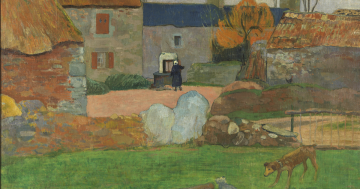
The National Gallery of Australia is hugely popular with visitors but may face the decision to close for several days each week. Photo: Jack Mohr.
Closure for up to two days per week, entry fees and further redundancies may all be on the cards for the National Gallery of Australia as the nation’s major collecting institution says it has reached crisis point after years of efficiency dividends.
Gallery staff would only say “The Minister clearly understands our financial position and we are working with him on this” and NGA director Nick Mitzevitch was unavailable for comment.
A letter obtained by the Nine papers under Freedom of Information provisions has revealed the full extent of the ongoing crisis.
In the letter to Arts Minister Tony Burke, gallery chair Ryan Stokes said the gallery will reach crisis point when short term funding of $24.77 million ends midway through 2023. He identified a shortfall of up to $265 million.
In recent years, $6.2 million in funding to stage exhibitions and programs has been stripped and 30 staff took voluntary redundancies as the pandemic hit.
A report commissioned by the NGA in June this year from Ventia Property put the cost of replacing ageing major assets in the heritage-listed building at $87 million.
The report said the $6 billion collection and staff were both at risk and repairs were urgently needed to security, fire, lighting, heating and cooling systems. There are questions over solvency while the building needs urgent waterproofing in display spaces and improvements to storage conditions.
There have been several injections of emergency funding in recent years but no ongoing commitment to repairing the building’s infrastructure.
The gallery was the target of multiple efficiency dividends along with most other national institutions over the term of the previous government.
Other institutions faced significant funding crises over the past five years including the National Archives, where irreplaceable artefacts could not be digitised and the National Library, which sustained funding cuts, staff losses and a lengthy battle to fund its archives including the Trove service.
The Australian War Memorial has been the exception, receiving $500 million for its controversial expansion plans, now underway.
Independent Senator David Pocock says he received multiple representations throughout his election campaign, reflecting the public’s concerns over the impoverished state of the national institutions.
Describing the gallery’s current situation as “perilous”, he said: “I understand such measures could include reduced operating hours, even closing its doors by as much as two days per week, serious staff reductions with at least half the current workforce at risk, as well as other closures and cutbacks.
“The National Gallery is tasked with managing the most valuable collection in the country, one that helps to tell the story of us and our evolving culture.
“It belongs to all of us, and it does little good if it can’t be preserved, curated, exhibited or made available to the Australians who pay for it.”
Arts minister Tony Burke said the national institutions had experienced “a decade of neglect” and described the former government’s approach as a culture war that had pushed them to the brink.
He said the Albanese Government was “acutely aware” of the pressures and was working through issues. However Senator Pocock noted that the gallery’s funding is projected to shrink in the next financial year and across the forward estimates.
“No other multi-billion-dollar investment, whether public or private, would be left to grapple with these types of decisions,” he said, noting the national institutions in Canberra should be prioritised in the May budget.



















